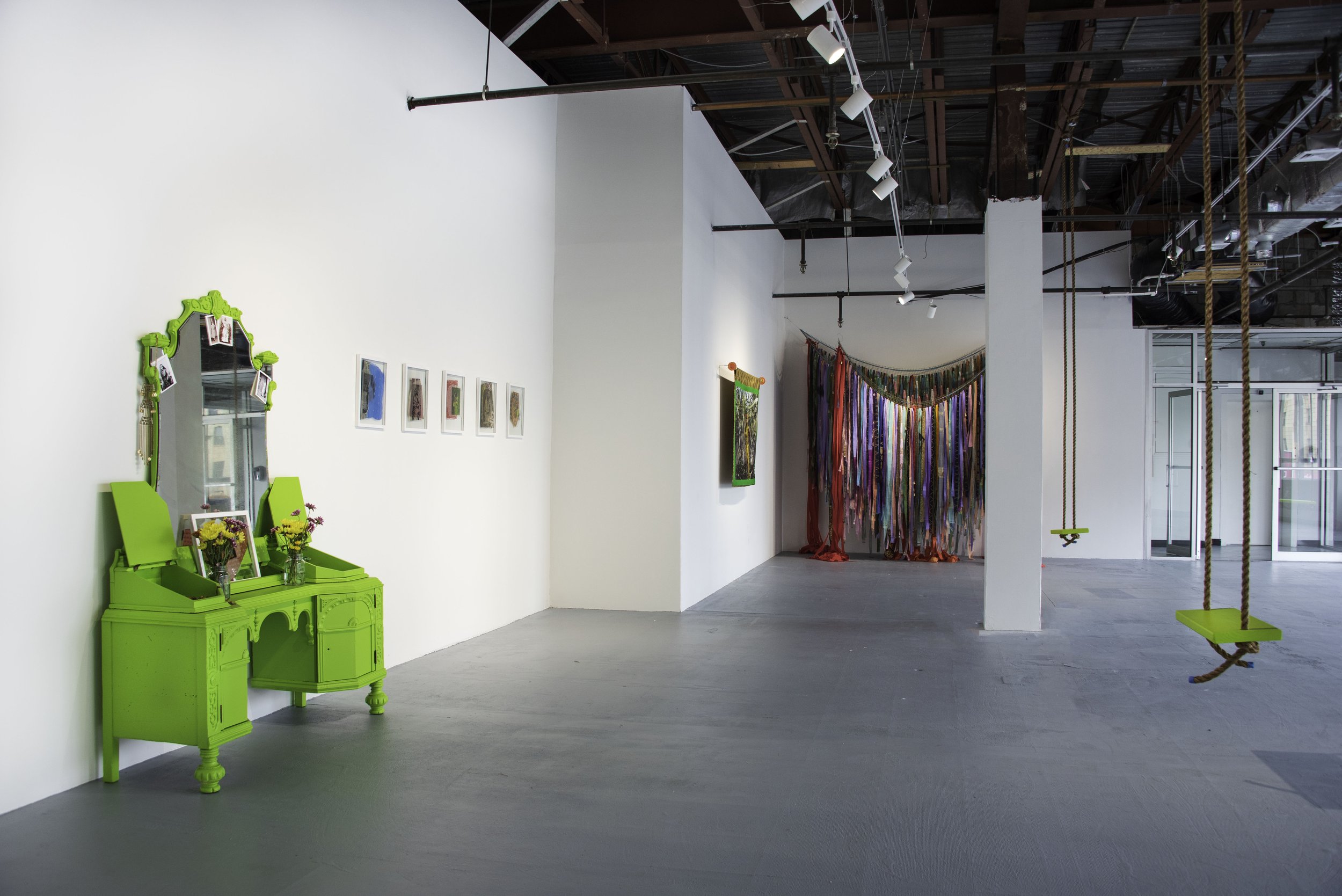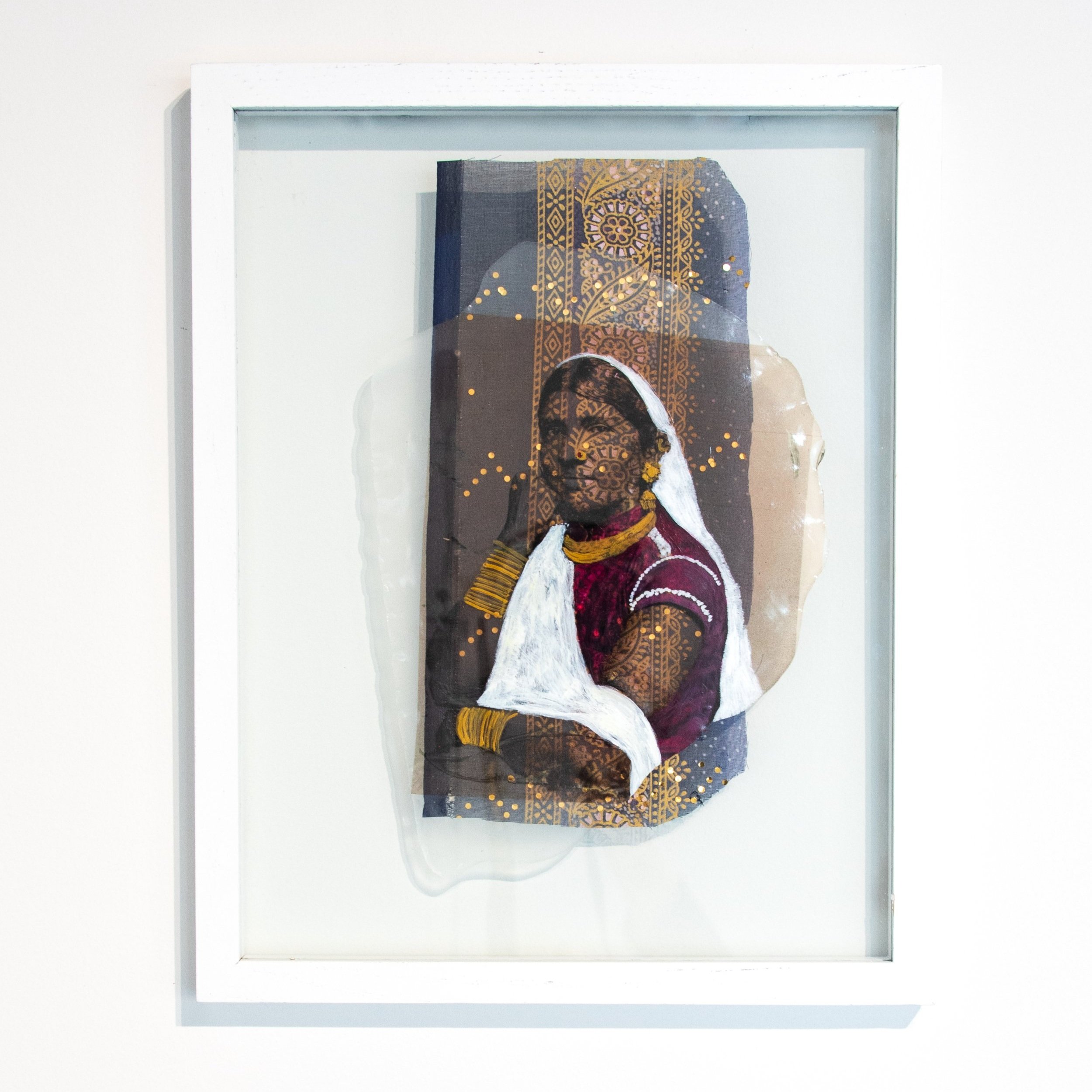BHUMI’S DAUGHTERS
October 1, 2022 - January 21, 2023
Project for Empty Space is pleased to announce Bhumi’s Daughters, an exhibition of new mix-media and installation works by 2022 Artist in Residence Renluka Maharaj. Bhumi’s Daughters will be on view from October 1st, 2022 - January 21st, 2023. The PES gallery is open Wednesday - Saturday from 11 am - 6 pm.
Spanning multiple areas across Project for Empty Space, Bhumi’s Daughters is a visual and performance-based exercise in restorative ancestral healing for the spirits of South Asian women who were indentured in the Caribbean islands during the nineteenth and twentieth centuries. The artist draws from both her own family history, extensive historical research, and an array of digital photographic archives. The finished paintings envision possibilities of reparative growth of hundreds of thousands of women who crossed oceans into servitude.
The exhibition begins with an immersive video projection in the PES Lobby. The projection features documentation from Maharaj’s March for the Ancestors. Performed by a twelve-member ensemble with participants from the Indo-Caribbean community in Queens, NY, the march pays homage to the physical labor and hardship endured by the participants' forebearers. Resplendent in silk, and gold jewelry, the performers carry fabric collaged banners adorned with photographs of family members. The twelve women weave down the streets of Little Guyana (also known as Richmond Hill) during the South Queens Women’s March, which happens to be during Pitru Paksha, the Hindu festival of the ancestors. At the end of the march, the collective convenes in Smokey Park and builds a temporary altar of remembrance. The public is invited to share food and stories and partake in dancing. March for the Ancestors not only commemorates the ancestors but also reminds viewers of a history that has largely been forgotten. Upon entering the Project for Empty Space, audiences are reminded of these multitudinous and simultaneous histories across multiple centuries and geographies as one becomes enveloped in the experience.
From the lobby, viewers are invited into the main gallery on the second floor where they are greeted by collaged nineteenth and twentieth-century Indo-Caribbean women. Against the far back wall, photo-based paintings, which are vaguely reminiscent of the standards carried by the women in March for the Ancestors, hang from brightly colored cotton fabrics that resemble chintz from India. In the center of each painting is a sole, black and white or sepia-toned figure. The figures are each posed formally, in the convention of British-style studio portraits that were so popular of the time. Unlike the demure photographs of English women, the women in these collages stare stoically at the viewer. The women are heavily adorned in jewelry- gold and silver hammered bangles cascade down skinny sunkissed arms; payals (ankle bracelets) tinkle around sharp ankles; jhumkas jangle out of stretched lobes; a twinkling tikka peaks out from a silk pallu pinned carefully to an oiled-hair-scalp.




Maharaj has spent years gathering photographs of her subjects. They come from open source web footage, eBay hauls, family, friends, and beyond. None of the women in the photographs are known, while others maintain mysterious anonymity, a common phenomenon for non-European women in the colonies. The artist uses these archival materials in a process of rejuvenation and restoration for the figures in the photographs. She enhances their garments, effectively re-adorning and restoring them. She painstakingly paints and draws atop scaled-up prints. Her additions bring brocades alive, and soften the silks with parrot and emerald greens; amber and deep gold thread through jewelry; electric turquoise and azure sizzle across the picture plane propelling the memory of these women to the front of our eyes. Through this process, she creates an elevated reincarnation- a type of recognition, visibility, and love, for these women of the diaspora.
This process of re-adornment is not only reserved for the larger pieces in Bhumi’s Daughters. It manifests in a constellation of smaller photographic collages. These experimental pieces also use archival photographs that are printed as transparencies on an acrylic skins and interlaid with scraps of fabric. These small-scale pieces live with an interior installation reminiscent of the island bedroom of the artists' youth. Framed like family photographs, the small collages sit atop a vintage dresser. The scene is intimate, familiar, haunting, and beautiful. It reminds the viewer that visibility does not have to be loud or public- being remembered and acknowledged by only a few is enough.
The pseudo-domestic scene is not the only installation in the exhibition. The final piece in the exhibition is Samundar, 2022, a five-foot wide net installation hanging in a gallery corner. Gently sagging, the fishing net is embellished with scraps (scraps of sarees of various hues). More tiny photos on clear substrates also hang amongst the forest of fabrics. It is a gentle immersive installation and one that is more elegiac than the other works in the exhibition. Samundar is an homage to the women and children who lost their lives crossing the oceans from the subcontinent to the Caribbean. Lost between homelands, the stories of these individuals were swept away into oblivion, until now. The gently swaying textiles floating above the heads of viewers bring forth memories, histories, and collective experiences to the forefront.








About the Artist
Renluka Maharaj was born in Trinidad and Tobago and works between Colorado, New York City, and Trinidad. She attended the University of Colorado, Boulder where she earned her BFA. She received her MFA from The School Of The Art Institute of Chicago. She has received numerous awards including Martha Kate Thomas Fund, the Presidential Scholarship at Anderson Ranch Center, and the Barbara De Genevieve Scholarship. Her works are in institutional collections including The Art Institute of Chicago, Museum of Contemporary Photography in Chicago, Joan Flasch artist book collection, Los Angeles Center for Digital Art, Flaten Museum, and special collections at the University of Colorado, Boulder as well as numerous private collections.
Her work has been recognized with awards including fellowships from the Vermont Studio Center, Fountainhead Residency, Virginia Center For Creative Arts as well as The Golden Art Foundation and the McColl Art Center Residency in North Carolina. She will also be attending a residency at Project For Empty Space in Newark, New Jersey in 2022. Most recently, her work has been published in the second volume of Coolitude co-authored by Khal Thorabully and Marina Carter, a volume of stories, poems, and visual art which addresses Indian indentureship. Her work has also appeared in Elle India, Harper's Bazaar India, New American Paintings, Hyperallergic, Juxtapoz Magazine, and the Washington Post.


